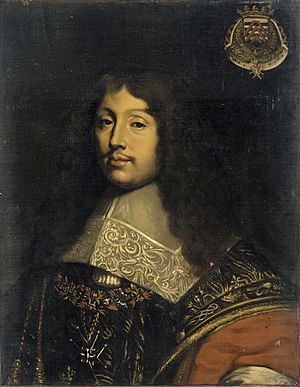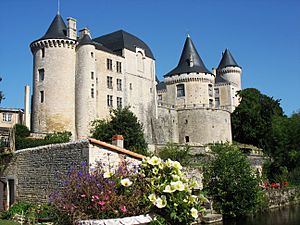François de La Rochefoucauld (writer) facts for kids
Quick facts for kids
François de La Rochefoucauld
|
|
|---|---|
 |
|
| Born | 15 September 1613 Paris, Kingdom of France |
| Died | 17 March 1680 (aged 66) Paris, Kingdom of France |
| Nationality | French |
| Genre | Essayist |
| Notable works | Memoirs Maximes |
| Spouse | Andrée de Vivonne |
| Children | François VII de La Rochefoucauld |
François VI, Duc de La Rochefoucauld (born September 15, 1613 – died March 17, 1680) was a famous French writer and thinker. He is best known for his short, wise sayings called maxims and his personal memoirs. He was part of a literary style called classicism.
François was born in Paris. This was a time when the French royal court was often changing its mind about how to treat the powerful noble families. He was seen as a perfect example of a nobleman from the 1600s. Until 1650, he was known as the Prince de Marcillac. His great-grandfather, François III, was killed during a terrible event called the St. Bartholomew's Day massacre. This happened because his great-grandfather was a Huguenot, a French Protestant.
Contents
Life of a French Nobleman
Growing Up: 1613–1629
François de La Rochefoucauld was born on September 15, 1613, in Paris. As a young nobleman, he received an education focused on military skills, hunting, and how to behave at court. He learned how to speak and act elegantly.
When he was just 14, he married Andrée de Vivonne. She was a distant cousin of Catherine de Vivonne, who would later become a famous marquise. François came from one of France's most important noble families. At 16, he became a camp master for a military regiment.
His Time in the Army
The next year, François joined the army. He quickly became a well-known public figure. He fought bravely in many battles each year. However, his actions were never officially recognized.
François became friends with Madame de Chevreuse, an important woman who influenced his life. Through her, he joined the service of Anne of Austria, the Queen. He got involved in plots against Cardinal Richelieu, a powerful minister. These plots sometimes led to him being jailed for a short time or sent away from the royal court.
After Richelieu died in 1642, François tried to get the Queen and Prince Condé to work together. But another powerful minister, Cardinal Mazarin, gained influence. In 1645, François became close with the Duchess of Longueville. This made him a "frondeur," which means an aristocratic rebel.
He played a big part in the siege of Paris. He fought in many battles and was badly hurt at the siege of Mardyke.
The Fronde Rebellion
During the second part of the Fronde rebellion, François de La Rochefoucauld joined forces with Prince Condé. In 1650, at his father's funeral, he encouraged other nobles to help him attack the king's soldiers in Saumur. In a battle in 1652, he was shot in the head. Everyone worried he would lose his eyesight, but he recovered after a year.
After this, he went to live at his country home in Verteuil. His family's money had been greatly reduced. But over time, he managed to get some of it back. This was mainly thanks to a loyal servant named Gourville. Gourville had worked for him and later for Mazarin and Condé, gaining wealth and influence.
François did not return to the royal court until just before Mazarin died. This was when King Louis XIV was about to take complete control. The time of noble rebellions, like the Fronde, was over. During this period, François wrote his memoirs, just like many other important people of his time.
Life at the Salons and His Writings
Before this, François had started spending time in the "salon" of Madame de Sablé. A salon was a gathering place where important people, especially writers and thinkers, met to discuss ideas. Madame de Sablé's salon was known for writing short, wise sayings.
In 1662, a Dutch company secretly published what they claimed were his memoirs. This caused him both trouble and fame. Many of his old friends were upset because the book wasn't exactly what he had written. He quickly said it wasn't real, but people didn't believe him.
Three years later, in 1665, he secretly published his famous book, Maximes (maxims). This book made him a very important writer. Around the same time, he became close friends with Madame de Lafayette. This friendship lasted for the rest of his life. We know about his later life mostly from the letters of Madame de Sévigné. These letters show him suffering from gout, but generally happy.
He had many loyal friends and was known as a top writer and moralist. His son, the Prince de Marcillac, took over his titles in 1671. He had a good position at court. François de La Rochefoucauld was seen by his friends and even the king as a great example of the older nobility. This reputation has stayed with him to this day.
François de La Rochefoucauld's ideas about human behavior have sometimes been criticized. He saw politics as a game played by powerful people, not as a fight over ideas or a way to help society. He seemed to be very honest in his own actions. His struggles in the noble world were often because of this honesty.
He died in Paris on March 17, 1680.
His Important Literary Works
François de La Rochefoucauld's importance as a historical figure is matched by his great place in French literature. His main writings are his Memoirs, his Maximes, and his letters.
His Memoirs are very interesting and well-written. The first book claiming to be his memoirs was published in the Netherlands. Even though he said it wasn't real, it kept being printed for about 30 years. It turns out that book was put together from the writings of several different people. Only about a third of it was actually written by La Rochefoucauld. It took a long time for a more accurate version to appear.
However, his short, elegant Maximes had a different story. He often changed and added to them during his life. A few more were added after his death. Today, they are usually published all together, with 504 maxims. Most of them are only two or three lines long. La Rochefoucauld writes about how people act and why they do things. He shares his observations as a man of the world, without trying to make them sound nicer than they are.
In his introduction, he even advises readers:
...the best approach for the reader to take would be to put in his mind right from the start that none of these maxims apply to himself in particular, and that he is the sole exception, even though they appear to be generalities. After that I guarantee that he will be the first to endorse them and he will believe that they do credit to the human spirit.
His Lasting Influence
Many great French critics of the 1800s wrote about La Rochefoucauld.
The philosopher Friedrich Nietzsche admired La Rochefoucauld very much. He was influenced by his ideas about behavior and also by his writing style.
The versions of La Rochefoucauld's Maximes published during his lifetime came out in 1665, 1666, 1671, 1675, and 1678.
See also
 In Spanish: Francisco de La Rochefoucauld para niños
In Spanish: Francisco de La Rochefoucauld para niños



